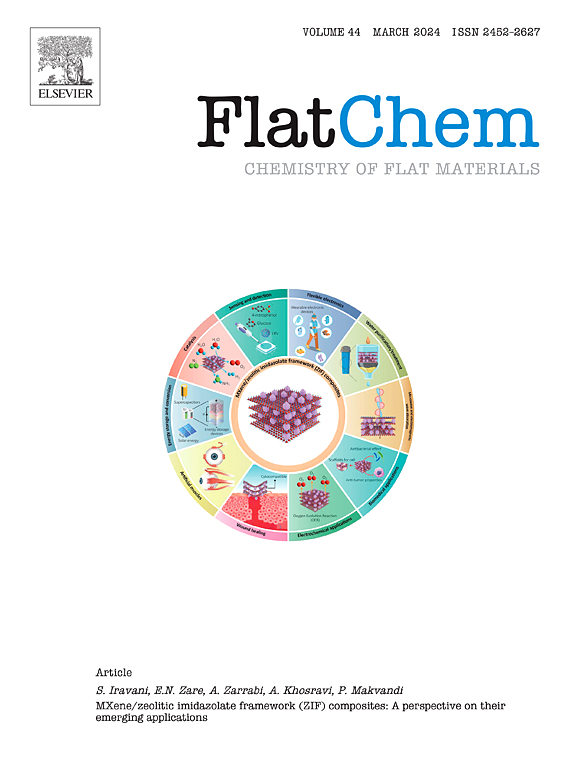Unlocking the potential of Mo2TiC2 MXene: synthesis, properties, and applications in energy and beyond
IF 6.2
3区 材料科学
Q2 CHEMISTRY, PHYSICAL
引用次数: 0
Abstract
Mo2TiC2 MXene, a member of the expanding family of two-dimensional transition metal carbides, has emerged as a highly promising material owing to its unique layered structure, tunable surface chemistry, and excellent physicochemical properties. This review presents a detailed and focused analysis of Mo2TiC2 MXene, with an emphasis on its synthesis strategies including conventional hydrofluoric acid-based and environmentally benign fluoride-free methods. Surface modifications and chemical functionalization approaches are discussed to highlight how these treatments enhance stability, dispersibility, and application-specific performance. Structural, mechanical, and thermoelectric characteristics are critically evaluated to establish a foundation for understanding the material's behavior under diverse conditions. The review further explores a wide range of applications, including its use in energy storage (supercapacitors, lithium-ion and sodium-ion batteries), energy conversion (photocatalytic hydrogen evolution and electrocatalysis for HER/ORR), and environmental remediation. Emerging applications in hydrogen storage, biomass conversion, sensing technologies, nonlinear photonics, and photocatalysis are also addressed. Recent theoretical insights based on DFT calculations are incorporated to provide atomic-level understanding of electronic structure, surface reactivity, and interaction mechanisms. Despite the promising advancements, challenges such as large-scale synthesis, structural stability, and limited exploration in biomedical and photothermal applications remain. Future research directions are outlined, including hybridization with other functional materials, advanced computational screening, and scalable green synthesis methods. By consolidating current progress and identifying critical knowledge gaps, this review serves as a timely and comprehensive resource, aimed at accelerating research on Mo2TiC2 MXene for next-generation applications across energy, environment, and emerging technologies.

释放Mo2TiC2 MXene的潜力:合成、性质和在能源及其他领域的应用
Mo2TiC2 MXene是二维过渡金属碳化物家族中的一员,由于其独特的层状结构、可调的表面化学性质和优异的物理化学性质,已成为一种非常有前途的材料。本文对Mo2TiC2 MXene进行了详细的分析,重点介绍了Mo2TiC2 MXene的合成策略,包括传统的基于氢氟酸的合成方法和无害环境的无氟合成方法。讨论了表面改性和化学功能化方法,以突出这些处理如何提高稳定性、分散性和特定应用性能。结构,机械和热电特性进行严格评估,以建立理解材料在不同条件下的行为的基础。综述进一步探讨了其在能量存储(超级电容器,锂离子和钠离子电池),能量转换(光催化析氢和HER/ORR电催化)以及环境修复方面的广泛应用。在储氢、生物质转化、传感技术、非线性光子学和光催化方面的新兴应用也得到了解决。基于DFT计算的最新理论见解被纳入到电子结构、表面反应性和相互作用机制的原子水平理解中。尽管取得了可喜的进展,但诸如大规模合成、结构稳定性以及在生物医学和光热应用方面的有限探索等挑战仍然存在。展望了未来的研究方向,包括与其他功能材料的杂交、先进的计算筛选和可扩展的绿色合成方法。通过巩固目前的进展和确定关键的知识差距,本综述可以作为及时和全面的资源,旨在加速mo2tic2mxene在能源、环境和新兴技术领域的下一代应用的研究。
本文章由计算机程序翻译,如有差异,请以英文原文为准。
求助全文
约1分钟内获得全文
求助全文
来源期刊

FlatChem
Multiple-
CiteScore
8.40
自引率
6.50%
发文量
104
审稿时长
26 days
期刊介绍:
FlatChem - Chemistry of Flat Materials, a new voice in the community, publishes original and significant, cutting-edge research related to the chemistry of graphene and related 2D & layered materials. The overall aim of the journal is to combine the chemistry and applications of these materials, where the submission of communications, full papers, and concepts should contain chemistry in a materials context, which can be both experimental and/or theoretical. In addition to original research articles, FlatChem also offers reviews, minireviews, highlights and perspectives on the future of this research area with the scientific leaders in fields related to Flat Materials. Topics of interest include, but are not limited to, the following: -Design, synthesis, applications and investigation of graphene, graphene related materials and other 2D & layered materials (for example Silicene, Germanene, Phosphorene, MXenes, Boron nitride, Transition metal dichalcogenides) -Characterization of these materials using all forms of spectroscopy and microscopy techniques -Chemical modification or functionalization and dispersion of these materials, as well as interactions with other materials -Exploring the surface chemistry of these materials for applications in: Sensors or detectors in electrochemical/Lab on a Chip devices, Composite materials, Membranes, Environment technology, Catalysis for energy storage and conversion (for example fuel cells, supercapacitors, batteries, hydrogen storage), Biomedical technology (drug delivery, biosensing, bioimaging)
 求助内容:
求助内容: 应助结果提醒方式:
应助结果提醒方式:


